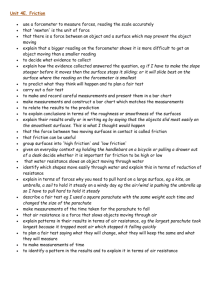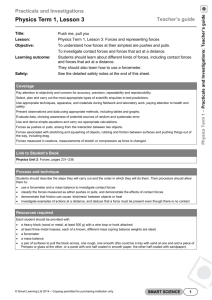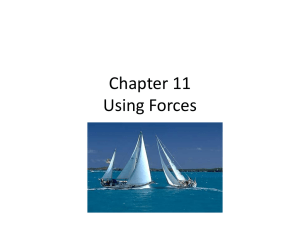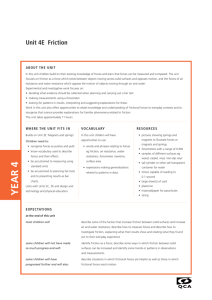View lesson plan
advertisement
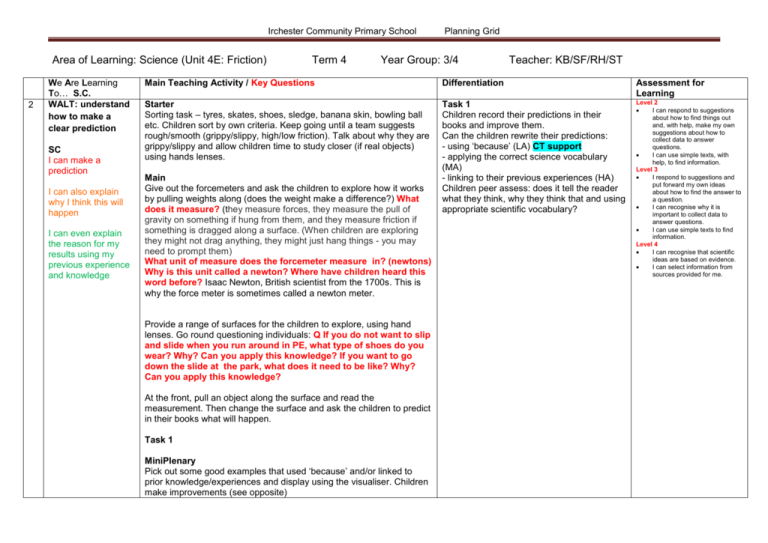
Irchester Community Primary School Area of Learning: Science (Unit 4E: Friction) 2 We Are Learning To… S.C. WALT: understand how to make a clear prediction SC I can make a prediction I can also explain why I think this will happen I can even explain the reason for my results using my previous experience and knowledge Term 4 Planning Grid Year Group: 3/4 Teacher: KB/SF/RH/ST Main Teaching Activity / Key Questions Differentiation Assessment for Learning Starter Sorting task – tyres, skates, shoes, sledge, banana skin, bowling ball etc. Children sort by own criteria. Keep going until a team suggests rough/smooth (grippy/slippy, high/low friction). Talk about why they are grippy/slippy and allow children time to study closer (if real objects) using hands lenses. Task 1 Children record their predictions in their books and improve them. Can the children rewrite their predictions: - using ‘because’ (LA) CT support - applying the correct science vocabulary (MA) - linking to their previous experiences (HA) Children peer assess: does it tell the reader what they think, why they think that and using appropriate scientific vocabulary? Level 2 I can respond to suggestions about how to find things out and, with help, make my own suggestions about how to collect data to answer questions. I can use simple texts, with help, to find information. Level 3 I respond to suggestions and put forward my own ideas about how to find the answer to a question. I can recognise why it is important to collect data to answer questions. I can use simple texts to find information. Level 4 I can recognise that scientific ideas are based on evidence. I can select information from sources provided for me. Main Give out the forcemeters and ask the children to explore how it works by pulling weights along (does the weight make a difference?) What does it measure? (they measure forces, they measure the pull of gravity on something if hung from them, and they measure friction if something is dragged along a surface. (When children are exploring they might not drag anything, they might just hang things - you may need to prompt them) What unit of measure does the forcemeter measure in? (newtons) Why is this unit called a newton? Where have children heard this word before? Isaac Newton, British scientist from the 1700s. This is why the force meter is sometimes called a newton meter. Provide a range of surfaces for the children to explore, using hand lenses. Go round questioning individuals: Q If you do not want to slip and slide when you run around in PE, what type of shoes do you wear? Why? Can you apply this knowledge? If you want to go down the slide at the park, what does it need to be like? Why? Can you apply this knowledge? At the front, pull an object along the surface and read the measurement. Then change the surface and ask the children to predict in their books what will happen. Task 1 MiniPlenary Pick out some good examples that used ‘because’ and/or linked to prior knowledge/experiences and display using the visualiser. Children make improvements (see opposite) Irchester Community Primary School Show the children what happens? How much does the forcemeter change by? Was this what we expected? Plenary Four corners – 4 possible reasons for the results in the corners of the room. Children choose the most appropriate answer and need to be able to justify why. Establish that a large force is needed to move an object across a rough surface. A rough surface produces more friction than a smooth surface. Therefore a bigger reading on the forcemeter shows it is more difficult to get an object moving than a smaller reading. Get the children to realise that it is lumps and bumps on surfaces which collide, rub and snag when dragged over another surface to cause friction. The smoother the surface, the less friction will occur, however no surface is completely smooth - they will still have microscopic ridges and bumps. Planning Grid
